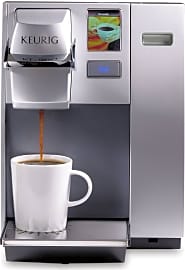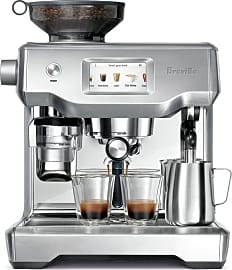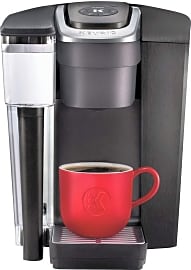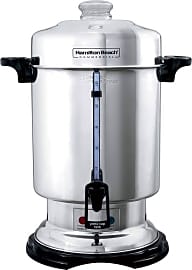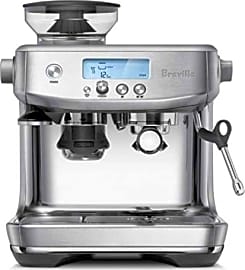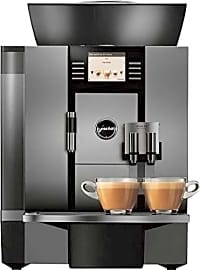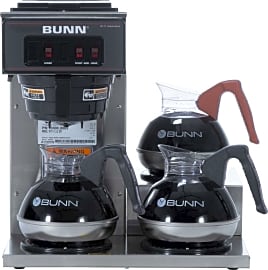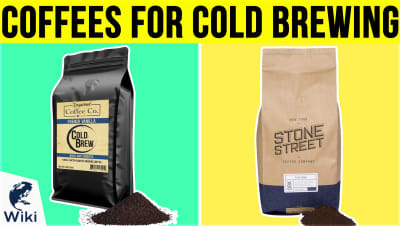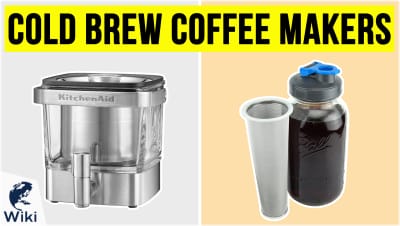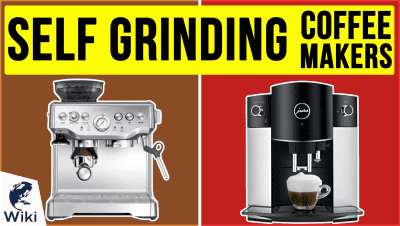The 10 Best Commercial Coffee Makers

This wiki has been updated 34 times since it was first published in September of 2016. Although these commercial coffee makers would satisfy the caffeine cravings of die-hard java fanatics at home, they're designed for use in restaurants, offices and other high traffic areas. Capable of producing large quantities quickly and efficiently, these robust machines can serve up poured-over, percolated or cold-brewed coffee in abundance for clients, employees, customers and guests. When users buy our independently chosen editorial recommendations, we may earn commissions to help fund the Wiki.
Editor's Notes
December 02, 2020:
The most important decision to make when selecting a commercial unit is how much choice you wish to offer your guests or customers. If you want to keep employees happy by offering gourmet drinks in a variety of styles, an espresso machine like the Breville Oracle Touch is hard to beat. The Breville Barista Pro is less expensive and provides more control, but requires the user to know how to get the most out of it. While the Jura GIGA W3 has a helpful screen and impressive capacity, it's a big, expensive unit that may be out of your price range.
For serving a big group at a function, you'll want as much coffee on hand as possible, as well as portability. The Gastrorag Premium and Hamilton Beach Urn are excellent choices, but the Yama Glass has the added benefit of looking great and providing trendy cold brew.
The most common use for these machines, however, is to provide coffee for an office break room or customer waiting room. Keurig has two quality machines, the Keurig K1500 and Keurig Office Pro, with the Keurig Office Pro being slightly easier to use, though both require pods. To simplify things, you can go with the Bunn Stainless or Bunn 12-Cup, which provide classic coffee in large quantities with little fuss. The Bunn 12-Cup tops the list this time around because it comes with everything you need, it's a fast, reliable unit, and it's compact enough to fit almost anywhere.
December 09, 2019:
Coffee is essential not only to many people's dining experiences, but also their workdays. Models like the Bunn Pourover and Wilbur Curtis G4 ThermoPro are great for use in restaurants of various sizes, though they're not ideal for high-end cafes or self-service coffee bars. If you can take the time to set it up well beforehand, the Wilbur Curtis Cold Brew is a great option for providing huge batches of delicious, low-acidity brew, but it certainly can't make any coffee on demand. The Hamilton Beach BrewStation and Focus Foodservice 57060, meanwhile, take well under an hour to produce huge amounts of the good stuff, making them great for large gatherings such as those managed by professional catering companies. And whether it will be placed in the kitchen, behind the bar, or in a convenience store, the Wilbur Curtis Gemini is one of the most reliable choices and can accommodate two types of coffee at once -- traditionally, of course, decaf and regular.
If you're looking for something a little classier, though, we have you covered there as well. The Elektra Micro Casa SX can make more espresso than any one person could safely drink, and it looks simply amazing as well. Alternately, the Keurig K150 allows purchasers and individual users to choose whatever flavor is their favorite, as it uses the incredibly popular pod system the brand is based on. And if you are setting up a high-end cafe, the Yama Glass is hard to beat in terms of cold-brew systems; its bold and open appearance will give customers peace of mind that you're running a quality establishment. Similarly, the Breville Oracle Touch is an all-in-one grinder and espresso machine that can turn an average snack bar into a java-drinker's dream.
You can also find some on-demand, single-serving machines that let users select their favorite beverage and then do all the work of heating and frothing the milk, then dispensing the drink, with minimal user effort. You can find a couple of these streamlined options in our Special Honors section.
Special Honors
Lavazza EP 2500 Plus No matter what your employees' tastes are, they'll be able to pick something they like with this fully automated machine. It uses the brand's popular single-dose capsules and does have a milk reservoir, so everything from black coffee to cappuccino is ready at hand. lavazza.com
Starbucks Serenade The Serenade is a versatile and comprehensive solution that uses an intuitive 17-inch touchscreen to take orders and provides a single serving of freshly brewed coffee on demand. It's suitable for use in a well-equipped break room as well as in cafe dining rooms and even allows for per-use customer payment. starbucks.com
A Personal Brew On The Commercial Scale
In an office of your own, where the commercial coffee machine is intended to perk up other workers, you’ll see a number of benefits.
There’s a good chance you remember your first cup of coffee, the first time you tasted what would come to be one of the most important beverages of your life. If you were on the younger side, you might not have liked it very much.
I recall my first cup rather clearly. My mother was volunteering on the mayoral campaign of an old friend, and she took me along to the campaign offices to see how politics worked at the local level. I must have been eight. While the group busily prepared for their last push the weekend before the election, I wandered the offices, eventually finding myself face-to-face with a coffee machine.
It was an older style commercial unit — like a giant percolator —, and it was nearly empty. I grabbed a Styrofoam cup and mixed in milk and sugar just as I’d seen the grownups do. To an eight-year-old accustomed to sugary sodas and fruit juices, it was pretty awful, but I can remember the taste clearly, even now, and looking back it was a fine cup of Joe.
It’s well known that coffee increases alertness, and the heightened state of awareness we have when downing our very first cup of the good stuff might be enough to help cement the memory in our minds. If that cup is particularly well-made, then all the better for our personal posterity.
For your business, whether you plan to sell the beverage, or just to keep your employees happily caffeinated throughout the day, purchasing a commercial coffee machine is an excellent investment. In a sales environment, you never want to be out of coffee. If you’ve ever been to brunch and heard that the restaurant’s coffee machine was on the fritz, one look around the room at the faces of the patrons would show you the irreparable damage this can do to a small business.
In an office of your own, where the commercial coffee machine is intended to perk up other workers, you’ll see a number of benefits. For starters, there will be fewer times when an employee sneaks in a miniature break by taking 10-15 minutes to brew a fresh pot of coffee in a simple, household coffee maker. With a commercial system, it’d be a challenge for your workforce to make their way through an entire brew before lunch.
Given that there’s so much more coffee at the ready, employees also don’t have to feel guilty about taking too much. That means everyone will be more caffeinated and more productive.
How To Choose The Right Commercial Coffee Maker For You
You’ve no doubt noticed that there are several different styles of commercial coffee maker on the market. Which one suits your needs will be a matter of some minor inquiry, but a few key variables will cause the right machine to float to the top of the barrel. Knowing whether you intend to use your machine to sell coffee or to caffeinate employees is probably the most important consideration.
In the former case, you’re free to choose a model for its aesthetics, as most of the options out there will serve your purposes.
In a sales setting, you’ll either have customers serving themselves or a wait staff bringing out fresh coffee to tables. In the former case, you’re free to choose a model for its aesthetics, as most of the options out there will serve your purposes. Note, however, that models featuring open coffee pots are more susceptible to tampering if they sit in a common area accessible to customers. It wouldn’t take much for a miscreant to slip a dangerous chemical into a pot. In the latter case, with a wait staff at work, coffee pots are essential. Depending on how much java your business sells, you might want to maximize the number of pots and hot plates to keep them warm, so you never run out of the black gold.
In an office setting, the most important considerations are likely capacity and ease of use. While a shop might have one or two people dedicated to making the coffee whenever it runs out, an office large enough to necessitate the use of a commercial pot is liable to have any number of potential do-gooders trying to refill the pot once it’s finally empty. If the mechanism is easy to operate, there’s a much smaller chance that they’ll screw up the brew. An office without caffeine is a dangerous place.
Of course, there is one other category of customer for these commercial machines, and that’s the avid coffee drinker — and I mean avid. If you or your family consumes more than a full pot of coffee from a household machine each day, it might be worth investing in a small commercial machine to save you a little time and help maintain those jitters.
A Brief History Of Brewing
The first coffee plant was discovered in Ethiopia in the 11th century. According to legend, it was a goat herder who noticed an uptick in his goats’ energy levels after seeing them eat a certain kind of berry. Their energy levels were so high that the herder couldn’t get them to go to sleep that night. The goat herder took his discovery to the abbot of a local monastery, who distilled a drink from the berries by mixing them in water.
By the turn of the 16th century, coffee cultivation had proliferated all around the Arabian peninsula. Eventually, European travelers tried the beverage and brought it back to their home countries. From there, conquistadors and other explorers brought the berries with them to the new world, where cultivation exploded through the centuries.
It’s been a long time since those developments, but coffee’s foothold in history is as strong as a muddy French press brew. It is possible that cultivation could drop off in the future, as climate change alters the agricultural landscape. It’s up to us, then, to enjoy as much of it as we can, while we can.


